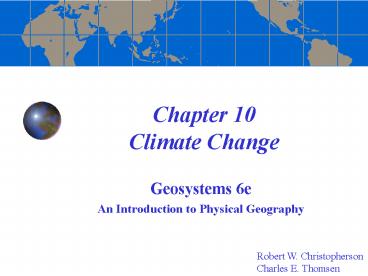Chapter 10 Climate Change PowerPoint PPT Presentation
1 / 28
Title: Chapter 10 Climate Change
1
Chapter 10Climate Change
- Geosystems 6e
- An Introduction to Physical Geography
Robert W. Christopherson Charles E. Thomsen
2
Causes of Climate Change
- Variations in the Earths orbital characteristics
- Atmospheric carbon dioxide variations
- Volcanic eruptions
- Variations in solar output
- Humans
3
Greenhouse Gases
- Human activities are enhancing the Earths
natural greenhouse effect - Carbon dioxide, methane, nitrous oxide, CFCs, and
water vapor - Greenhouse gases are transparent to sunlight but
opaque to longwave radiation
4
(No Transcript)
5
Carbon Dioxide
- Atmospheric CO2 levels began rising during the
Industrial Revolution - Tremendous fossil fuel burning and heavy
deforestation increased CO2 levels this trend
continues - CO2 is responsible for 64 of global warming
6
Carbon Dioxide Sources
7
What are the Fossil Fuels?
8
Carbon Dioxide Sources
9
Methane
- Methane currently increasing faster than CO2 in
the atmosphere - 19 of total atmospheric warming attributed to
methane - Methane generated by rotting vegetation,
digestion in cattle and termites, burning of
vegetation, and melting permafrost
10
Methane (CH4)
11
Volcanic Eruptions
- Sulfur dioxide reacts with water vapor causing
haze - Combined with ejected particulate matter
- One of the coldest years in the last two
centuries was 1816, the Year Without a Summer - Caused by eruption of Tambora in 1815
- Temperatures can decrease after eruptions for up
to 3 years
Mount St. Helens
12
Variations in Solar Output
- Climate models predict that a change in solar
output of only 1 percent per century alters the
Earths average temperature by 0.5 -1.0 C - Sunspots
- Huge magnetic storms
- Seen as dark (cooler) areas
- on the sun's surface.
- Cycle every 11, 90, and
- 180 years
13
GCM Predictions
- Crop patterns and natural plant/animal habitats
will shift to maintain preferred temperatures - During this century, climate regions could shift
90-350 miles poleward - Soil moisture projected to decrease in
midlatitudes
14
GCM Predictions
- Forest cover will undergo major species
disturbances - Expansion of zones affected by tropical diseases
- Alpine glaciers
15
Global Temperatures
1.4C 2.5F
Figure 10.28
16
Temperature Anomalies for 2003
Figure 10.28
17
Sea Level Issues
During this century, global warming will cause
sea levels to rise at least 1.5 meters (about 4.5
feet).
18
Sea Level Rise
- During the 20th century, sea level rose 4-8
inches - Could rise 3.5-34.7 inches this century
- Thermal expansion of water will increase sea
level rise - Higher sea levels destruction of small island
nations, river deltas, lowland coastal farming,
barrier islands
19
July 2029 Temperature Forecast
Figure 10.31
20
Disintegration of Ice Shelves
- In 2002, Larsen-B ice shelve collapsed in 35 days
after existing for 11,000 years - Warmer ocean and air temperatures are melting
shelves on both sides - Clear evidence of changes in Earths energy
balance
21
Antarctic Ice Disintegration
Figure 10.32
22
Arctic Climates
- Changes in ocean temperatures could alter global
temperatures - Arctic region warmed 9F since 1987
- This has led to a freshening of northern oceans
- Greenland ice melting at 1m/year
- Permafrost is melting
- Increased precipitation in Arctic/Antarctic areas
23
End of Chapter 10Climate Change
- Geosystems 6e
- An Introduction to Physical Geography
Robert W. Christopherson Charlie Thomsen
24
Chapter 19 Ecosystem Essentials
- Geosystems 6e
- An Introduction to Physical Geography
Robert W. Christopherson Charles E. Thomsen
25
Ecology
- Study of relationships between organisms and
their abiotic environment - Can be studies at several levels
- Population
- Community
- Ecosystem
- Biosphere
Fig 1.8
26
Communities
Fig. 19.3
27
Community Terms
- Habitat
- Type of environment where an organism resides
- Niche
- Function of a life form within a community
- In stable community, no niche is left unfilled
- Competitive Exclusion Principle applies
- No two species occupy same niche at same time
28
Interactions in communities
- Competition
- Negative for both species (/)
- Symbiotic/Mutualistic (/)
- Both species benefit
- lichen (fungi and algae)
- Predation and Parasitic (/)
- One benefits, one loses

